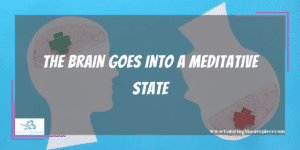Science is giving us some pretty good reasons for trying out coloring. It’s not just for kids anymore. Adult coloring books are all over shelves at bookstores, big box stores, and any website that sells books.
It’s being said that coloring can provide the same benefits to the mind and body that things like meditation and yoga do. These cause reactions in the brain which are good for overall health. That’s why we’re taking a look at how coloring affects the brain according to science right here.
Coloring is gaining in popularity because it allows colorists to escape and let go of everyday stressors while they create something beautiful. In recent decades, there’s even been an emergence of art therapy, where coloring is being used by therapists to help treat their patients who suffer from anxiety, depression, and high levels of stress. Read on to find out more about how this fun activity can put you in a better state of mind, body, and spirit.
The Brain Goes Into a Meditative State

Meditation is used to train your brain to let go of the repetitive, troublesome thoughts we often get bogged down by and redirect our thinking so we can focus and de-stress. It helps to increase our concentration abilities and allows us to become more self-aware.
To get to a meditative state of mind, you have to be able to let go of everything you’re worried about and all the things you normally occupy your time thinking about. Coloring gives your brain something to focus on that isn’t all of those things that stress you out or increase your anxiety level. You have to look at the page in front of you, pay attention to all the details, choose colors, and watch the edges of what you’re coloring in.
The fact that coloring is a task that can have a predictable outcome also lends to its potential to help your brain relax. There’s a reason people take up hobbies like knitting, photography, and other things like coloring. There’s predictability in all of these. We’ll say a little more about this later.
The Brain Relaxes, Decreasing Activity in the Amygdala
Adults deal with a lot of different thoughts all day long. As we get into the “thick” of our lives, there are many more things for us to worry about than there were when we were younger. People get married sometimes, start a family, take on mortgages, purchase cars, build credit card debt, and juggle schedules that are increasingly busy as families get older. There are financial stressors, time stressors, relationship stressors, and health stressors, as well as many other types.
The amygdala is the part of your brain that is responsible for the “fight or flight reaction” that gets stimulated in your body by outside factors. The amygdala causes stress hormones to be released into your body which can wreak havoc on your stress and anxiety levels.
When you color, the focus and attention it takes to do the activity allows your brain to relax. In turn, the amygdala relaxes allowing your hormone and chemical levels to even out. This results in you feeling less anxiety and stress.
Some research points to coloring in mandalas and geometric shapes as a more specific way to reduce stress and anxiety. According to a published study in Art Therapy: Journal of the American Art Therapy Association, coloring the aforementioned kinds of pages lowered the amount of anxiety felt by graduate students in this experiment. There were 84 students in all, some of whom were given mandalas to color in, some got plaid pages, and some were given blank paper. The two groups who were given the mandalas and plaid felt their anxiety levels decrease, while there was no difference for the group given blank paper.
The researchers conducting this study found that because the mandalas and the plaid offered a complex structure, it provided the subjects with something to focus harder on. The new focal point brought on the meditative mindset and led to the anxiety slipping away.
The Brain Replaces Negative Thoughts with Positive Ones
Inner dialogues and thoughts can be very negative. We think much faster than we talk, though. Typically we think about three to four times faster than we talk. That means that if you’re thinking negative thoughts, you’re thinking them much faster than any conversation would ever go. They can be extremely damaging to your psyche and overall emotional state.
Coloring can take those negative thoughts and replace them with positive ones. For most people, coloring is an activity that they did when they were kids. Coloring takes them back to a time when life was simpler and there weren’t so many worries and stressors.
Your brain conjures images from back then in the part of your brain that would normally be filled with imagery that induces anxiety. The more positive imagery can then knock the negative stuff out of the way. You then feel less stress and anxiety. It’s soothing and gives your mental and emotional state a big boost so you feel better overall.
This whole process can ultimately lead to the release of hormones and chemicals in the brain that also help to produce positive physiological changes in the body. When there are patterns, details, and repetition involved in your activity, it triggers positive neurological responses. This then can lead to a cycle where you want to color more because you feel good when you color due to the reactions in your body. You add more coloring sessions into your life and feel happier and less stressed more of the time. You may even start seeing a different pattern developing in your thought process when you’re not coloring because you’re training your brain to do so.
The Brain Focuses On the Task at Hand

You’ve likely experienced those times when you can’t seem to get control of your thoughts. Especially at times when you don’t have anything else to focus on, it can seem like your brain just does its own thing. You can’t seem to turn it off sometimes.
What helps in these situations is to have something else that takes your attention away from the thoughts that plague you. It’s like when you hear about people throwing themselves into their work after a bad breakup or something else that’s trying. It gives them something else to think about, therefore making them not think about the thing that is troubling them so much.
Coloring is something that you can dive into. It requires a lot of attention and allows you to think about what you’re doing rather than about what you’re worried about. You have to pay attention to the edges, pick what color comes next, figure out how to add depth to your picture and work at making it look the way you want it to. All of that means you have to focus on the task at hand so your brain can’t focus on something else.
At the same time, that focus isn’t something unpleasant. The kind of focus this takes is pulling from a part of your brain that helps you be creative. Coloring to create a piece of artwork is about self-expression. It’s relaxing and soothing, so you’re putting your focus into something that isn’t stress and anxiety-inducing.
The Brain Becomes Calm
While we keep talking about the focus it takes to color, and how it requires your attention, it’s not something that you have to overthink or worry about. It requires enough thought to take your focus away from the things you stress about, but not so much that it wears your brain out.
Coloring allows your brain to calm down and rest. It relaxes because it’s able to let go of some of its awarenesses. This is an activity that is not about time limits, competition, or achievement. It’s all based on your creativity and what you want the picture to look like. It’s purely for fun and nothing else.
Also, because there is such a high level of prediction involved with coloring, that leads to the calmness of your brain. The inability to predict what’s going to happen next is troublesome for your brain. It’s along the lines of the fear of the unknown. That lack of predictability can trigger the stress response from the amygdala. Coloring is predictable for your brain. It knows what’s coming because of the repetition and the patterns. The nature of this activity brings your brain down to a calmer level.
Rather than wind down with a television show or something else that requires looking at a screen, sitting down to color before going to bed can lead to much better sleep after a long day. The light you’re exposed to from the screen time works against your body in terms of its production of melatonin—the sleep hormone. An activity such as coloring takes away that light exposure and works to calm your brain down before lying down to sleep.
The Brain Can Achieve Mindfulness
Mindfulness is a concept that has its origins in Buddhism but has spread all over the world and is increasing in popularity throughout Western civilization. To be mindful means to be aware and present in the moment. You are to maintain your awareness of your inner thoughts, the environment around you, what you’re feeling, and the sensations that affect you.
Another part of that is a lack of judgment about your awareness. You are to be accepting of what you think and how you feel. You don’t worry too much about the future and you don’t keep looking behind you at the past. You stay within the present.
Coloring is helping people to achieve mindfulness, if only just in that time when they are participating in a coloring session. It’s an activity that you immerse yourself in but that doesn’t require deep thought so you focus on the moment and escape whatever else is going on in your life for a little while.
When you color, you are not the center of your thoughts anymore. Your brain sets that aside so it can give attention to the coloring page in front of you. Coloring is what you’re doing in that moment so that’s what your brain thinks about. The activity puts you into a state of mindfulness. In time, the more you make this a part of your normal cycle, you may feel your patterns of thought shifting so that you can find mindfulness outside of your coloring sessions as well.
Art Therapy
Art therapy is being used in all kinds of different settings to help people cope with traumatic experiences, decrease stress levels, lower anxiety, work through emotions, develop better self-esteem, handle addictions, and manage depression. There is an emergence of this type of therapy being seen in counseling centers, hospitals, senior living facilities, community centers, and even correctional facilities.
Medical professionals have found that art therapy can wake up parts of the brain that hold memories which helps us to better understand people’s behaviors and motivations. Coloring is one of the activities that’s highly used as a therapeutic mechanism. It involves looking at what you produce in your creative sessions, but also the art therapist’s observation of how you create your final product.
Mental health professionals who are trained as art therapists have an understanding of what the use of different colors, art mediums, and textures will elicit from patients in terms of how the brain processes them. Also, they can use that training to better understand where a patient is coming from. Color choices, mediums used, and other visual aspects can signify specific things about emotional states, coping skills, and other elements of mental health. The observation of patients’ coloring sessions serves as a window into their brains.
Research Continues

Our understanding of how coloring affects the brain is still growing. There is ongoing research that is delving deeper into the benefits provided to the brain and how it all affects the mental and physical states of those who participate in coloring regularly.
What we already know is that coloring puts the brain into a meditative state. It relaxes the brain and helps it emit hormones or other chemicals that help to lower stress and lessen anxiety. Coloring lets you replace your negative thoughts with more positive thinking. It can help you sleep better, feel better, and achieve mindfulness so you can be more present in your life. As we look further into how coloring affects the brain according to science, the list of benefits continues to grow.
Now that you know the benefits of coloring, discover my free adult coloring eBook and sign up for my email newsletter HERE!
Disclaimer: The information provided by ColoringMasterpiece.com (“The Site”) is for general informational purposes only. All information on the Site is provided in good faith, however, we make no representation or warranty of any kind, express or implied, regarding the accuracy, adequacy, validity, reliability, availability, or completeness of any information on the Site. Under no circumstance shall we have any liability to you for any loss or damage of any kind incurred as a result of the use of the Site or Reliance on any information provided on the Site. Your use of the Site and your reliance on any information on the Site is solely at your own risk. This blog post is for educational purposes only and does not constitute legal advice. Please consult a legal expert to address your specific needs.
Terms and Conditions: https://coloringmasterpiece.com/terms-and-conditions/

